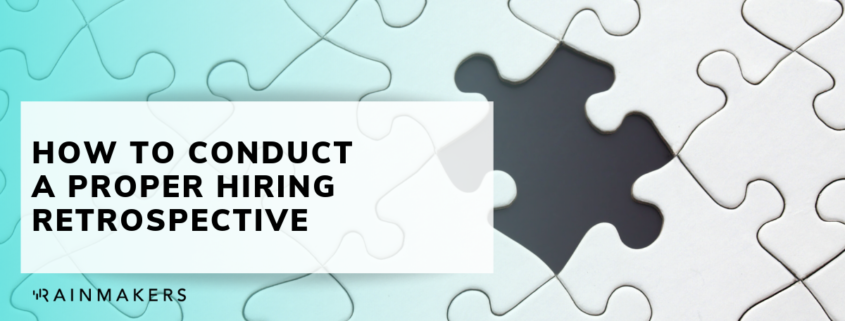How to Conduct a Proper Hiring Retrospective and the Timeline for an Effective Hiring Process
Sales Hiring Process
In the early stages of a fast-growing startup, the founder handles much, if not all, of the process behind interviewing and hiring. First, the founder has the vision for where they want the company to go and who they need to bring on board to reach that goal. Then, through trial and error, they find what works best when interviewing and hiring and how to build on that vision for the future.
As the startup grows, the founder takes on more executive-only tasks like fundraising, opening new offices, and board meetings. Leadership or HR will now need to take over the process of formal interviews when this transition occurs.
This is where a hiring retrospective comes into play. It will be a guideline or SOP (Standard Operating Procedure) for the new hiring manager to follow. This can include steps, checklists, and observations that helped the founder grow the employee base.
The goal of the retrospective is to help the new hiring team understand what has and hasn’t worked in the past and keep the interviewing and selection process consistent, no matter who is hiring. If done right, the long-term value of a retrospective will show through a more efficient and effective hiring process that onboard the best possible candidates.
Some best practices for facilitating a hiring retrospective agenda are:
- First, meet with Leadership and HR to discuss open positions and the applications received for the job.
- Take detailed notes on any insight provided by Leadership or HR about who they liked and didn’t like among the candidate pools.
- Keep adding to and refining the retrospective as time progresses to include new aspects of the business or new positions.
- Review the retrospective with new Leadership or HR team members.

How to Build a Hiring Retrospective Study
You should be as thorough as possible when building and documenting the ideal hiring process. The new hiring manager should be able to read everything and clearly understand what to look for and think. Here are some steps to go through when building the outline for the retrospective:
Hold hiring retrospective meetings with department leaders and stakeholders to get input from each about what makes effective employees for their teams. These discussions should be held early on, as soon as the founder thinks of passing some of the hiring duties on to other Leadership or HR team members.
For example, Imagine you are hiring a new sales director and have whittled down the candidate pool to the top 10 applicants. Your meeting about who to hire should include a CRO or VP of Sales (sometimes both), the CEO (you), the Head of HR/Talent/People, and any other relevant team members you find appropriate.
Start the conversation with the purpose of the position, the goals the business wants to achieve once the position is filled, and what the most critical attribute is for a candidate to have.
Have everyone review the available resources that the candidate provided (resumes, video interviews, websites, etc.). Next, go around the room and review the top candidate that everyone liked first. Then, allow them a few minutes to explain what they liked about the candidate and why they think they would be a good fit for the role.
Ask questions like:
What did you like about this candidates background?
How did the candidate handle the interview questions?
Do you see the candidate bringing value to the business?
Once the best candidates have been reviewed, please go over the remaining candidates and have everyone explain why they weren’t their first choice.
Ask questions like:
What makes you think this candidate isn’t ready for the position?
Were there any red flags about this candidate?
Would you hire them if our first and second choice didn’t accept the position?

Ensure everyone provides input on all the candidates they interacted with to get the most well-rounded opinion from the discussion. Then, when the final 1-2 candidates are chosen, the hiring decision can be handed over to the CEO for final approval.
Once a final decision has been made, send a follow-up email to everyone who participated in the meeting, thanking them for their feedback. In addition, encourage them to communicate any afterthoughts, revelations, or ideas that come to mind even after a decision has been made.
All insight gained from discussions like these should be added to the broader hiring retrospective. In addition, this should be an ongoing conversation as more positions open within the company.
Create a personality profile with the key attributes of the team members who are successful in the position. Include examples of qualities the perfect employee would have to fit the cultural and technical aspects of the company. For example, here is a great one this company uses to define Successful CHRO:
Record relevant information about candidates who were both hired and turned down. Please write down their qualities and backgrounds and why they were or weren’t a good fit.
Questions you can ask yourself:
Were there concerns about their experience?
What makes the candidate a good fit for the company?
Were there any observations about their personality?
Make a checklist with the qualities relevant to a candidate’s success at the company. Examples include specific experience needed for the job, educational requirements, and personality traits.
Examples of checklist items:
- Educational background requirements
- Required technical certifications
- What they liked/dislike about past jobs
- What are their professional goals are
Track the length of employment for those who were hired. Record their performance reviews and provide insight into why specific patterns may occur.
Make a formal handbook or SOP that leadership or HR can be trained on that includes the information, insight, and best practices on hiring. Here is an example of what a hiring process SOP looks like. Have leadership or HR continue building on the hiring retrospective as needed with new data or observations.
Common takeaways from a retrospective include:
- Where to focus recruiting efforts
Where do most of the highest-performing employees come from?
- Repeating themes that reveal typical pros and cons of a candidate
What do the different groups of candidates have in common, and what makes them unique?
- What experience is needed before interviewing
Can the candidate be trained on something they don’t have experience in, or is that experience necessary before coming on board?
- A feel for the right personality traits that top candidates share. Certain personality traits that you are looking for in salespeople differ from operational support? Use this
Lastly, remember not to let any biased opinions you might have affected the hiring retrospective. Try to be as objective as possible when reviewing facts about a position and the candidates.

Conclusion
Documenting the hiring process and turning it into a retrospective will be an invaluable resource for the new leadership or HR team responsible for hiring. The main goal should be for the new administration or HR team member to be able to read the hiring retrospective and thoroughly understand the interviewing and hiring strategy put forth by the founder. As a result, they can now continue growing the employee base effectively.
If you’d like to create a timeline for hiring effective salespeople, here is an example of step by step:
Effective Hiring Timeline
Day 1: Meet with the team
Who: Leadership / Founder / Hiring Manager
Meet with leadership, founders, and hiring managers to decide on the job’s needs, titles, budgets, and which outlets will be promoted.
Day 2: Develop the job descriptions and add the open position to the company website.
Who: Leadership or Hiring Manager
Create a clear job description, including the needed requirements and capabilities.
Day 3: Create an image for social media posts, post the job to LinkedIn, etc.
Who: Social media team / Hiring Manager
Share the image, job description, and a link to apply on the company’s LinkedIn page. Remember to tag any stakeholders in the post. For ideas on images to create, check Canva.com and Google “we’re hiring images” for inspiration.
Day 4: Create a profile on the sales-specific hiring platform Rainmakers. co
Who: Founder or Leadership or Hiring Manager
Where: https://www.rainmakers.co/employers/
Add your company and develop your candidate needs. Batches of candidates will be delivered every Monday.
Day 5/First Monday after creating Rainmakers profile: Review candidates in Rainmakers
Who: Leadership or Hiring Manager
Look through the candidates interested in the position through Rainmakers.co. Since batches are delivered each Monday, there will be a consistent flow of applicants through the platform.
Day 6: Create jobs on relevant general job boards
Who: Team Leads / Hiring Manager
If you don’t find a suitable candidate after the first week on Rainmakers, you can post on general job boards like LinkedIn Jobs, Indeed, and Monster.
Day 9 – Day 20 Review resumes.
Who: Leadership or Hiring Manager
First, eliminate any applicants who, without a doubt, don’t fit the profile of the candidate you are looking for. Then, depending on the resumes you receive, you can go through them individually or use a screening tool to help narrow down the pool.
**If the position has not been filled:
Day 12: Review the next batch of applicants through Rainmakers.co
Who: Leadership or Hiring Manager
Review the second batch of candidates through the Rainmakers platform if the position has not been filled yet.
**If the position has not been filled:
Day 19: Review the next batch of applicants through Rainmakers.co
Who: Leadership or Hiring Manager
Review the third batch of candidates through the Rainmakers platform if the position has not been filled yet.
Day 21: Reach out to top resumes for a phone interview
Who: Leadership or Hiring Manager
After the first batch of resumes has been reviewed and narrowed down, you can begin contacting for phone interviews. The first phone interview can be relatively brief, 10-15 minutes, and can be viewed as a second screening device.
Day 22: Schedule face-to-face interviews
Who: Leadership or Hiring Manager
You can begin reaching out to schedule a face-to-face interview for the candidates who did well throughout the phone interview. It is recommended that the discussion itself should be held in a neutral space within the building, such as a conference room, not your office. Your questions should focus on the candidate’s experience related to the job requirements.
Day 23: Use a predictive assessment tool
Who: Hiring Manager
You may use a predictive assessment survey to determine the candidate’s current and future work skills.
Day 24: Schedule a second face-to-face interview
Who: Leadership or Hiring Manager
The second in-person interview can be used to answer any questions, clear up discrepancies, and sell the candidate for the position. This can also broadly explain what the compensation package would look like should they come on board.
Day 24 Continued: Job Shadow
Who: Leadership & Employees
While the candidate is in the office, it is an excellent time to have them shadow an employee for 30 minutes. Allow them to taste what the day-to-day aspects of the job are like and see their feedback on the experience.
**If the position has not been filled:
Day 26: Review the next batch of applicants through Rainmakers.co
Who: Leadership or Hiring Manager
Review the fourth batch of candidates through the Rainmakers platform if the position has not been filled yet.
Day 26: Check their references
Who: Hiring Manager
Call the candidate’s references and ask them about their experience and capabilities that relate directly to the job.
Day 27: Sending out a job offer
Who: Hiring Manager
If the right candidate makes it through the whole process and you and your team believe they would be the right fit for the company, send out a job offer. But, again, make important details like compensation, schedule, and benefits clear and unambiguous.
Day 28: Remove the open job listing
Who: Hiring Manager
If the candidate accepts the job offer, remove the open job listings from all relevant websites and job boards. Congratulations on your new hire.
Source: https://www.ecsellinstitute.com/steps-in-the-recruitment-and-selection-process



